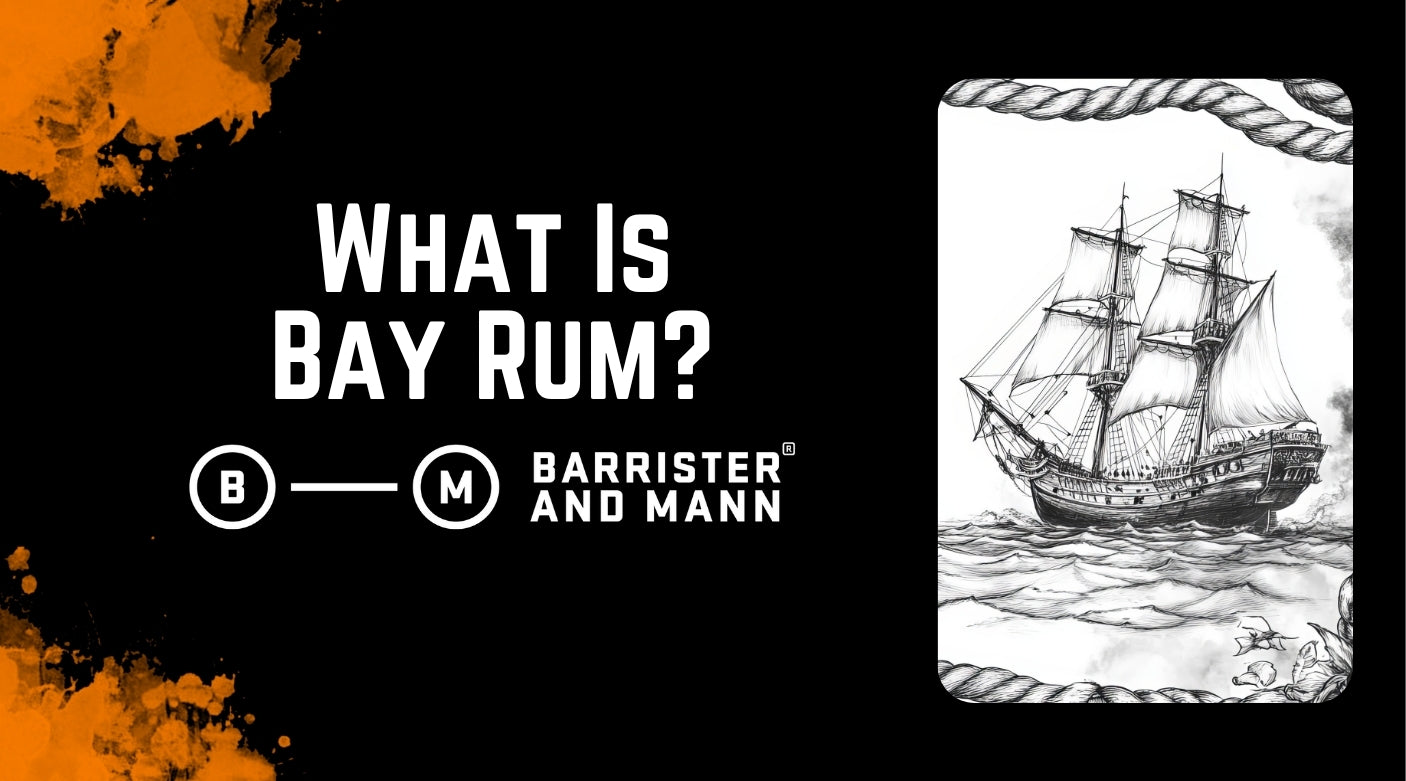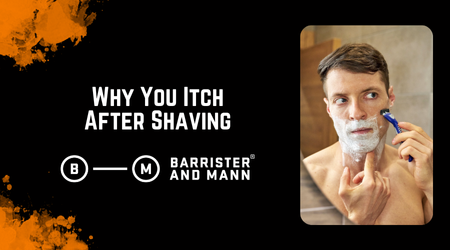Bay rum is a traditional grooming product made from West Indie Bay leaf and rum. It began as an antiseptic and cologne for sailors and remains popular today in aftershaves, soaps, colognes, and scalp tonics due to its distinctive spicy scent and skin-refreshing properties.
-
Bay rum originated in the Caribbean as a practical solution for hygiene and scent: Sailors in the West Indies steeped bay leaves in rum to mask body odor and disinfect minor cuts. It was gritty, improvised chemistry with lasting cultural impact.
-
The scent is spicy, warm, and unmistakably masculine: Notes of bay leaf, cinnamon, clove, citrus, and sometimes vanilla or balsam make it instantly recognizable. Some blends lean sharp and herbal, while others are smoother and rounder.
-
Historically used as aftershave, cologne, deodorant, and hair tonic: Barbers applied it post-shave, and men splashed it on their scalps. It was a one-stop grooming solution long before that became a buzzword.
-
Today, it lives on in modern artisan aftershaves, soaps, and fragrances. The format may have changed, but the heart of it has not. It remains a scent rooted in ritual and history, now reimagined for improved skin feel and greater complexity.
-
Some versions contain clove. Ours does not: Too much clove turns a good bay rum into a holiday candle. We use real blackstrap rum and benzoin instead, grounding the fragrance without the burn.
Let’s delve into the convergence of history and chemistry.
A Caribbean Origin Story: Where Bay Rum Comes From

Bay rum started with sailors. Not the charming, rum-soaked kind that stories romanticize, but the practical ones who needed something to mask the smell of two months in wool without a proper bath.
They took leaves from the Pimenta racemosa tree, soaked them in rum, and rubbed the mixture on their skin. Believe it or not, this worked, so they used it to deodorize and disinfect. The alcohol in the rum cleaned cuts and kept infections at bay. It was crude, but it did the job.
Over time, that rough concoction evolved. They added spices, citrus peel, cinnamon, and a few drops of clove here and there. What began as DIY hygiene eventually evolved into a ritual.
By the 1800s, barbers had picked it up. A splash of bay rum after a shave became standard. It cleaned up nicks, toned the skin, and left behind a spicy warmth that lingered long after the towel came off. The scent told you the job was done right.
Key components in the original blend:
-
Bay leaf (Pimenta racemosa): The heart of the scent and the reason it exists at all
-
Rum: Not just the carrier but the antiseptic punch
-
Cinnamon and clove: Used sparingly to warm and deepen the profile
-
Citrus peel: Brightens the top and keeps the blend from getting too heavy
When Prohibition hit, some clever folks realized the alcohol content in bay rum was strong enough to pass for a drink. That “for external use only” warning on the label? That was no joke.

The Classic Scent Profile of Bay Rum
Part of the appeal of Bay rum is its lack of subtlety. It is bold and unmistakable, a blend of warmth and spice that announces itself before you even walk into the room.
The foundation is always the same: bay leaf from the West Indies. But not the kind you toss into a soup pot. This is Pimenta racemosa, a variety with a scent closer to allspice and dry woods than anything you’d cook with. Add real rum, and you get a base that’s boozy, peppery, and deeply evocative.
Everything else is there to round it out. A splash of orange lifts the top notes, cinnamon adds a touch of heat, and benzoin brings soft, resinous sweetness that keeps the whole composition from veering into aftershave burn territory.
Then there’s clove. Some love it, some hate it. Most commercial bay rums lean on it heavily, resulting in a scent that smells less like cologne and more like a holiday candle.
We took it out entirely. Instead, we leaned on blackstrap rum and benzoin to give the same richness without the dental numbness.
Traditional Uses and Benefits Beyond the Scent

Bay rum earned its place by doing a lot with very little. Before it was fragrance, it was function. A single bottle could take care of shaving, grooming, and scent, all within a day's work. It was sharp, efficient, and unapologetically practical.
It started with aftershave. The alcohol cleaned up the minor damage left behind by a straight razor, and yes, it stung. That was part of the ritual. If it didn’t burn, it probably wasn’t doing its job.
It also worked as a hair tonic—not for a slicked-back look, but as a way to refresh the scalp. A quick splash helped clear buildup, reduce dandruff, and made sailors feel somewhat human again after sweating through their second wool uniform that day.
In hot climates, it doubled as a deodorant. The bay leaf oil killed bacteria. The alcohol kept it clean. It was easy to use and easier to carry than a bar of soap.
Then there was cologne. It was not meant to impress. It was meant to say you took care of yourself.
Everyday uses that made bay rum essential:
-
Aftershave: Closed wounds and tightened skin in one step
-
Hair tonic: Kept the scalp clean when shampoo was rare
-
Deodorant: Did the job when soap and water were not available
-
Cologne: Gave you a scent with weight and honesty
These functions aren’t outdated, they’re just often overlooked. Bay leaf oil still offers real antibacterial benefits. Paired with alcohol, it becomes a simple, effective way to fight acne, calm irritation, and rebalance the skin after shaving.
It also acts as a mild astringent: toning without stripping, cleaning without overcorrecting, and helping your skin bounce back from whatever you just put it through. But the sting? That’s still there, unless you do something about it.
That’s why we built the fragrance into a full set: soap, balm, and splash. The soap hydrates while it cleans, thanks to saccharide isomerate and cupuaçu butter. The balm skips the alcohol entirely, using oat protein and allantoin to soothe instead of sear. And the splash? It delivers that classic bite, but tempered with real blackstrap rum and benzoin to take the edge off.
Use it for the scent, the skincare, or the ritual. Bay rum works either way.
Why Some Bay Rums Burn
Bay rum sometimes gets a bad rap, which mostly comes down to how it feels going on. Traditional splashes are high in alcohol, and that’s part of the point. The alcohol tightens the skin, disinfects any nicks, and leaves a bracing finish. But if your blade was dull or your technique rushed, that splash can light you up.
Menthol and clove can make things worse. A touch of menthol adds a cooling kick, but too much feels aggressive. Clove brings warmth, yet when it dominates, it turns sharp and medicinal. That combination is what gives some bay rums their bite (and not in a good way).
The splash itself isn’t the problem; it’s the formula. A well-crafted splash balances alcohol with ingredients that support the skin, rather than stripping it bare.
What turns a splash from sharp to smooth:
-
Controlled alcohol content: Just enough to do the job without punishing the skin
-
Balanced spice: Cinnamon and bay leaf without clove overload
-
Skin conditioners: Ingredients like benzoin add warmth and softness
-
Real rum: Adds richness and depth instead of just burn
Our splash keeps the traditional structure but softens the blow. It uses real blackstrap rum and benzoin to round out the finish, delivering that classic post-shave feel without pushing it too far.
For those who prefer a gentler option, the balm skips the alcohol entirely. It brings in oat protein and allantoin to calm things down and rebuild the skin barrier. Same scent, different experience.
You do not have to choose between function and comfort. You just need the right version for how your skin feels that day.
Choosing the Right Bay Rum: What to Look For
Start with the clove. If you love it, you’re in the minority. Clove dominates easily and flattens everything else around it, which is why we left it out.
Hydration matters too. A good bay rum shouldn’t leave your face feeling like dried parchment. Look for ingredients that do more than just scent the formula, like shea butter or saccharide isomerate. These actually bind water to the skin.
Alcohol isn’t the enemy, but it should be used with intention. If your skin is reactive, skip the high-proof stuff and reach for something buffered. There are better ways to end a shave than with regret.
What makes a bay rum worth using:
-
Low or no clove: Keeps the scent from turning into spiced gum
-
Hydrating ingredients: Shea butter, saccharide isomerate, cupuaçu butter
-
Thoughtful alcohol use: Strong enough to work but balanced with soothing agents
-
In-house perfumery: Brands that formulate their own scents tend to get the details right
-
Character over harshness: It should smell like history, not like a bottle of cloves in a liquor cabinet

Want to Try a Bay Rum That Doesn’t Smell Like Every Other Clone?
There are plenty of bay rums out there, and most of them smell the same. Spiced, sharp, and heavy on the clove. Some burn, some vanish, and very few get it right.
Our version was built from the ground up. Instead of clove, we opted for real blackstrap rum and warm benzoin to smooth the edges. It’s the scent of tradition, reimagined for modern skin.
That’s why we offer it in five formats. Each one serves a different purpose, but all carry the same core scent. You get to choose how it fits into your routine, without losing what makes it bay rum.
Five Ways We Honour Bay Rum
-
Soap: Built with saccharide isomerate and cupuaçu butter to hydrate and protect while you lather
-
Balm: Alcohol-free, made with oat protein and allantoin to soothe and rebuild without the burn
-
Splash: Classic feel with real black strap rum and buffered with benzoin to smooth the edges
-
Body Soap: Made with responsibly-sourced palm, avocado, coconut, and olive oils.
-
Eau de Toilette: A longer-lasting take with real depth. Bold, warm, and unmistakably bay rum without the usual clove-heavy shortcuts
If your skin reacts to alcohol, the balm is the safer choice. If you want the traditional sting, the splash will get you there without going overboard. If you want the scent to follow you through the day, the Eau de Toilette has you covered. If you want it all to match, the soap and body bar pull it together.
There is no wrong way to wear it.




